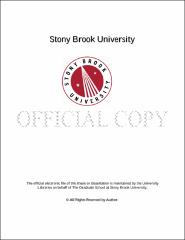| dc.identifier.uri | http://hdl.handle.net/11401/77069 | |
| dc.description.sponsorship | This work is sponsored by the Stony Brook University Graduate School in compliance with the requirements for completion of degree. | en_US |
| dc.format | Monograph | |
| dc.format.medium | Electronic Resource | en_US |
| dc.language.iso | en_US | |
| dc.publisher | The Graduate School, Stony Brook University: Stony Brook, NY. | |
| dc.type | Dissertation | |
| dcterms.abstract | With increasing demands for higher energy storage, Li metal with the highest possible energy density and specific capacity of 3800 mA h g-1 has come back into focus as an attractive candidate for an anode material. However, there are still critical difficulties involving safety issues caused by the growth of Li microstructures (dendrites and moss) during cycling, which prevent its use in practical applications. In order to solve the various problems, fundamental understanding of behavior of Li metal anodes in working batteries and the conditions under which Li microstructures are formed is necessary In situ NMR has a demonstrated ability to capture real time structural changes that are not obtainable via ex situ studies, such as the formation of metastable states and microstructural Li. In this research, I provide the first assignments of the Li metal NMR shifts to the different microstructure morphologies observed by SEM. The assignments are supported by susceptibility calculations, the results being critical in the development of a method to monitor cell failure in situ. Magnetic resonance image (MRI) has also been performed to study the change in concentration of the lithium ions in the electrolyte in the vicinity of the electrode interface during current flow. Sand’s time theory1 is employed to investigate the relationship between dendrite formation and electrolyte concentration. Non-destructive X-ray phase contrast tomography was applied to further characterize electrochemical Li symmetrical cells. In situ tomography allows examination of microstructure growth in 3D at high resolution. The multiple growth and removal mechanisms reflect the complexity of the lithium electrodeposition and dissolution process in Li batteries. The ability of the techniques performed here to distinguish between mossy and dendritic-type morphologies lays the groundwork for future investigations of Li depositions aimed at identifying the conditions (e.g., additives, applied current) where microstructural formation is minimized in practical Li metal-based batteries such as Li/S and Li/air. | |
| dcterms.abstract | With increasing demands for higher energy storage, Li metal with the highest possible energy density and specific capacity of 3800 mA h g-1 has come back into focus as an attractive candidate for an anode material. However, there are still critical difficulties involving safety issues caused by the growth of Li microstructures (dendrites and moss) during cycling, which prevent its use in practical applications. In order to solve the various problems, fundamental understanding of behavior of Li metal anodes in working batteries and the conditions under which Li microstructures are formed is necessary In situ NMR has a demonstrated ability to capture real time structural changes that are not obtainable via ex situ studies, such as the formation of metastable states and microstructural Li. In this research, I provide the first assignments of the Li metal NMR shifts to the different microstructure morphologies observed by SEM. The assignments are supported by susceptibility calculations, the results being critical in the development of a method to monitor cell failure in situ. Magnetic resonance image (MRI) has also been performed to study the change in concentration of the lithium ions in the electrolyte in the vicinity of the electrode interface during current flow. Sand’s time theory1 is employed to investigate the relationship between dendrite formation and electrolyte concentration. Non-destructive X-ray phase contrast tomography was applied to further characterize electrochemical Li symmetrical cells. In situ tomography allows examination of microstructure growth in 3D at high resolution. The multiple growth and removal mechanisms reflect the complexity of the lithium electrodeposition and dissolution process in Li batteries. The ability of the techniques performed here to distinguish between mossy and dendritic-type morphologies lays the groundwork for future investigations of Li depositions aimed at identifying the conditions (e.g., additives, applied current) where microstructural formation is minimized in practical Li metal-based batteries such as Li/S and Li/air. | |
| dcterms.available | 2017-09-20T16:51:50Z | |
| dcterms.contributor | Grey, Clare P | en_US |
| dcterms.contributor | White, Michael | en_US |
| dcterms.contributor | Miller, Lisa | en_US |
| dcterms.contributor | Kostecki, Robert. | en_US |
| dcterms.creator | Chang, Hee Jung | |
| dcterms.dateAccepted | 2017-09-20T16:51:50Z | |
| dcterms.dateSubmitted | 2017-09-20T16:51:50Z | |
| dcterms.description | Department of Chemistry. | en_US |
| dcterms.extent | 164 pg. | en_US |
| dcterms.format | Application/PDF | en_US |
| dcterms.format | Monograph | |
| dcterms.identifier | http://hdl.handle.net/11401/77069 | |
| dcterms.issued | 2015-05-01 | |
| dcterms.language | en_US | |
| dcterms.provenance | Made available in DSpace on 2017-09-20T16:51:50Z (GMT). No. of bitstreams: 1
Chang_grad.sunysb_0771E_12433.pdf: 26083395 bytes, checksum: 7d64170e82218f3e9d86c282b7d41969 (MD5)
Previous issue date: 2015 | en |
| dcterms.publisher | The Graduate School, Stony Brook University: Stony Brook, NY. | |
| dcterms.subject | Battery, Dendrite, Lithium, MRI, NMR, X-ray tomography | |
| dcterms.subject | Chemistry | |
| dcterms.title | Real-time Investigation of Li Microstructure Formation on Li Anodes for Li Batteries by Solid-state Li NMR, SEM, MRI and X-ray Tomography | |
| dcterms.type | Dissertation | |

